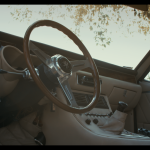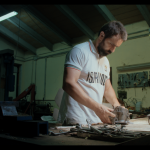
THE ISO RIVOLTA CHRONICLES: EPISODE III
Iso. Lele and Fidia.
Sculpture’s Masterpieces
Words by Manuel Bordini – English version by Nilla Pestrin
Photos by “An Italian Garage” and Alessandro Venier
In 1967, Piero Rivolta, short after taking over the firm in Bresso, realized that the high performing cars market was ready for a new range of Iso models. Iso Rivolta was producing the GT300/340 and the Grifo in various versions at that time. Although in 1962 the success of GTs had very solid bases and was an undoubtable brand new element, time did not fail to ill-treat Renzo Rivolta’s beloved car.
In 1967 sales began to slow down. What a few years before had been the symbol of a milestone in the way of making cars, was forced to give in to its own evolution.
Giorgetto Giugiaro’s line, a true inspiration to other models to follow, say Maserati, Mexico and Alfa Romeo GT was noticed for its sporty character, as comfortable as a sedan, and easy to drive in the city traffic. Renzo Rivolta used to say that his coupée was to be entered with your hat on; no compromise on comfort and smooth driving.
In 1964, during an interview, Mr. Barbieri, head of “Edizioni Scientifiche”, has revealed he had chosen his IR340 for its noiseless drive that let him and his fellow passengers talk as amiably as in his living room. He had not been able to do so, in his former cars (first in his Cavallino) but the GT was not a real priority. Piero, in fact, thought it could still continue selling well for a few years to come. He focused on a new model, in an area of interest still far from Iso’s vision. A highly performing car meant to destabilize his business competitors. After all, competition in that sector was modest, since Maserati Quattroporte was up to any request in the field of highly performing sedans. Meanwhile, Giugiaro, after leaving Bertone, had joined Ghia where Alejandro De Tomaso was to become chairman. Rivolta asked Giugiaro to design a new vehicle, with the body and mechanicals still being produced at Iso. So the GT300/340 chassis was made 20cm longer to easily make place for rear seat passengers. According to Rivolta’s and Giugiaro’s intentions, the line was to respect the body of a sedan and preserve what was typical of the brand: outline, sport and elegance. Giugiaro drew inspiration from his previous Grifo, designed only a few years earlier. Keeping the roof outlined and a well-balanced rapport among volumes, he created a new concept of a car; a coupé with four doors, the mechanicals being the same as in the GT and in the Grifo: a 5.4L Chevrolet, from 300 to 350Hp, Borg Wagner four-shift gear box or, on demand, a five-shift to F or a two-shift automatic box with torque convertor. The chassis was a masterpiece by Pierluigi Raggi, developed with Giotto Bizzarrini to grant solidity and roadability. A De Dion rear axle architecture made the difference in road handling. John Lennon was so bewitched by the new Iso that he decided to buy it as soon as he saw it at London’s Car Exhibition.
The first months were not without obstacles. The chassis arrived pre-assembled by Ghia and immediately showed problems in their fittings. A number of magazines wrote about water leaks during the tests, doors that would not close properly and other imperfections that could not be acceptable in such a high-ranking car. Piero Rivolta realized that the only way to make significant improvements in his products was to be able to check its phase of the production process and decided that chassis and internal parts had to be assembled in-house. This changed the story of the super sedan made in Bresso.
The S4 (45 S4s had been so far produced) was then replaced by the Fidia. The Fidia was first presented in 1968, on the Acropolis in Athens, below the Parthenon and took its name from the Athens temple’s architect and sculptor. Its fitting made the difference, being more accurate and of higher quality in leather and materials, sometimes personally chosen by Mrs. Rivolta at Franzi’s in Milan.
In 1969 the GT300/340 adventure had come to an end. Sales were definitely slowing down and time had come to present a new four-seats coupé model. The car that had been a benchmark for competitors was soon to end production.
The story goes in 1969 an American client asked for a one-off Iso. Based on the GT300, offering to pay for the project expenses too. Mr. Rivolta went back to Bertone’s and entrusted the design of the requested one-off to a young Marcello Gandini. In 1969 the car was shown at New York’s Car Exhibition and instantly became a hit among visitors and specialists. Piero Rivolta believed he had found the heir to his GT300/340: it was the Rivolta GT 2+2; no matter whether the story of the supposed American client was or was not true, in a few months the new car was in production.
On Christmas Eve 1969 Piero realized he had not bought a present for his wife Lele. Too late. Shops were closed. He could not stand disappointing his wife and an idea came across his mind. He reached his cellar, found a piece of wood, carved his wife’s name on it, wrapped it up and placed it under the Christmas tree. The next morning Lele opened her present and asked for an explanation. “Your present for this year is a new Iso car, the Lele” said a radiant Piero. Maybe his young wife didn’t feel the same enthusiasm, although her name was to be printed on car history books. The Lele represented a neat breaking point in the GT evolution, embodying the streamlined elements of the 70s as the GT 300/340 has represented those of the previous decade. Two eras so different from one another, based on opposite assumptions, but Rivolta could not possibly be aware of that, not in 1969.
Lele’s outline preceded that of Lamborghini’s Jarama. Some of the details would be found in many of the future cars, such as the Montreal: tense outlines, fast back tails, pneumatic eyelids and wide glass components.
All small series as well as Iso profusely used parts derived from production cars; for example, rear lights were from Fiat 124 Coupé and the front ones in S4 and Fidia were twins with Fiat 125’s. Lele, the GT substitute, offered a comfortable seat for four and mounted a Chevrolet 300/350Hp first and a Ford Cleveland 351C with 325Hp after 1972. They were regularly produced with manual gearbox, Borg Warner four-shift followed by 2F five-shift like in the Fidia, for the Italian market.
The S4s and the very first Fidias (first few of them to be made) used to mount Grifo’s dashboards and seats. After 1970 Fidia and Lele would present the same internal parts.
The Lele dashboard sports two central tubes already seen in the Espada and the modern design seats with integrated headrests. The power-train had already been seen in the GT as well as the chassis, without remarkable modifications. When the sale conditions imposed by GM became unsustainable for the Iso, Mr. Rivolta accepted some suggestions from Ford and replaced in 1972 the Chevy Block with a 351C Cleveland engine that had already been mounted on the De Tomaso Deauville and Pantera since 1971. The Cleveland, though, was heavier and bulkier than the Chevrolet and a chassis reinforcement was immediately necessary; Bizzarrini got hired once again and this was his chance to go back to Iso. The engineer form Livorno had been initially engaged by Renzo Rivolta to supervise the testing of the GT and the Grifo and help in the making of the Chassis. So, when Piero called him back, it was like coming home again. The Lele was to be produced in a “Sport” version, too, with a black resin bumper replacing the stainless steel one. The lightened inside parts and a “Marlboro” version was also produced (5 cars) to celebrate its debut in F1 with the Iso-Marlboro team, in 1973. A few years went by and the oil crisis had its consequences, rallies and trade union demonstrations invaded streets and squares. The supercars resembled what world protesters fought against in 1968; they were status symbols of that world. The new Iso owners opted to give up. The firm closed on December 31st 1974. 285 Leles and 192 Fidias had come out form the assembly lines. It was the end of Renzo Rivolta’s dream to make high performance cars that could match top speed, comfort and reliability altogether.
But the Iso Rivolta today is not entirely related to past experiences and the dream survives in the concept Vision designed by Zagato for the Gran Turismo Sport PS4 game; 5 pieces of the small series will also be made. Their mechanicals will derive from the Corvette Callaway, with a V8 twin turbo charged of 1,000Hp.
The Griffon, the winged lion, which complemented the products of the house in Bresso for so many years, will stand out again on a hood, carrying around everything that brand has represented for the Italian automobile excellence.
When you come across an Iso on the road, just wave at it. It will be like paying homage to Renzo and Piero Rivolta’s great adventure.




















